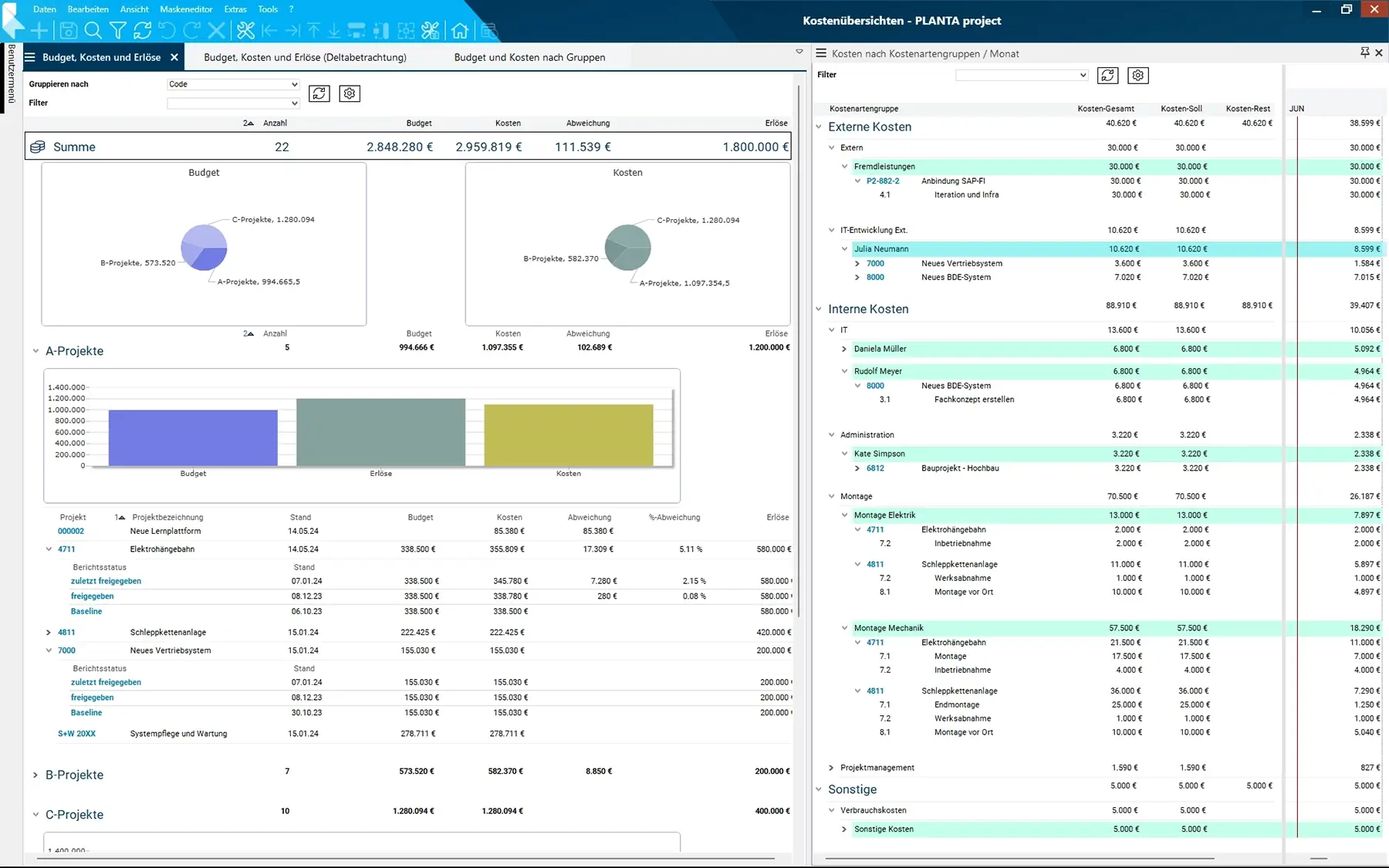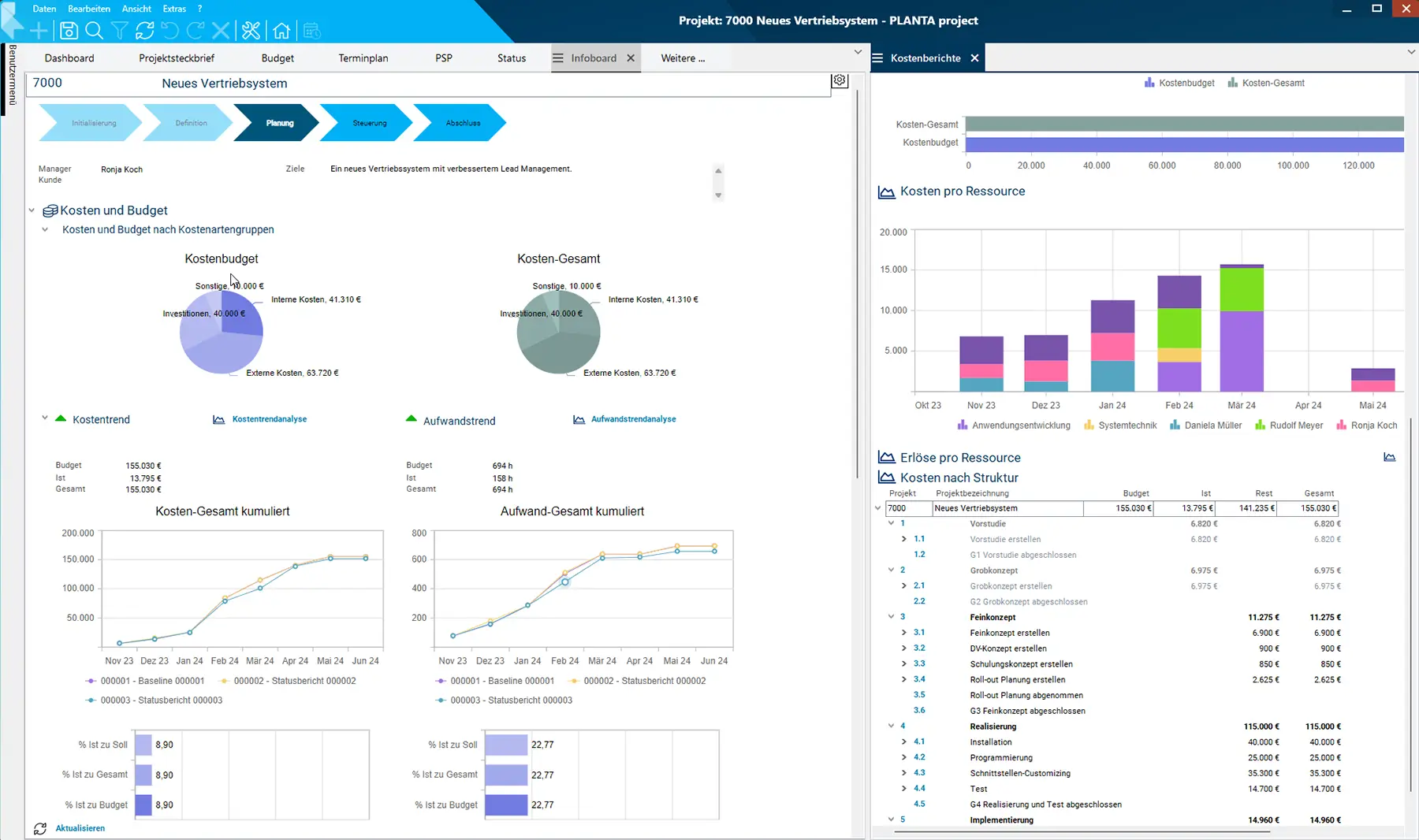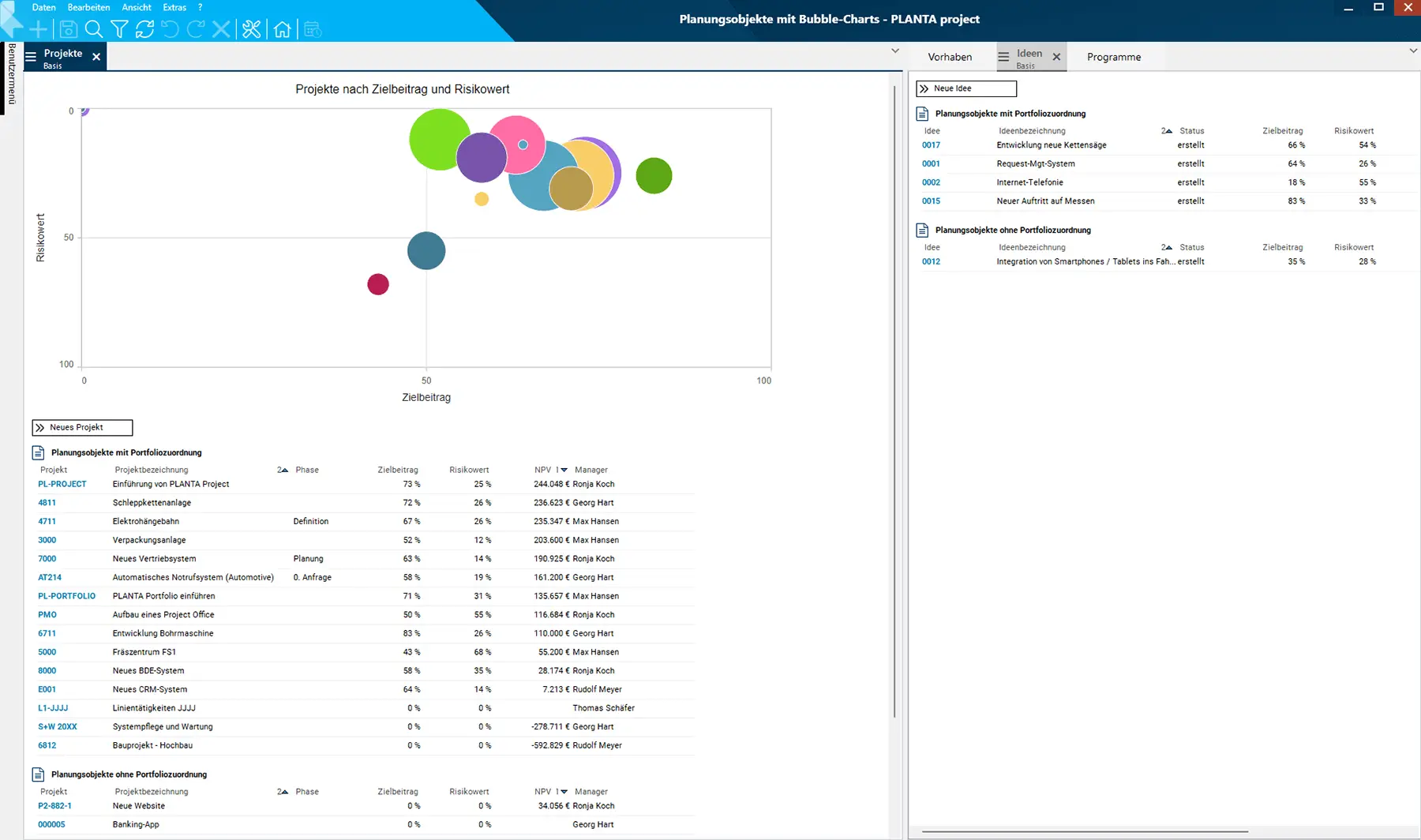Effective Cost Planning for Project Success
| Translated by Julian Hammer
The project conclusion is approaching but the costs already exceed the planned budget? Unfortunately, this scenario is not exceptional. Many projects struggle to keep project costs under control. This is precisely why cost planning is an indispensable part of project management. It ensures that all resources are used optimally and that your project is not only completed on time, but also within the planned budget.
How does cost planning contribute to a successful project conclusion? Effective cost planning helps you to adhere to your budget and is a decisive factor for the overall success of a project. It allows you to identify financial bottlenecks at an early stage, to minimize risks, and to make well-founded decisions. Without a solid cost plan, a project can quickly spiral out of control, leading to delays, increased costs, and ultimately to failure.
Thorough cost planning in project management includes the identification and classification of cost types, the creation of a detailed cost plan and the continuous monitoring of expenditure. Here, project management software plays a decisive role since it provides valuable support for budget monitoring and control.
This article does not only introduce you to suitable project management software and teach you the theoretical basics of cost planning. It also provides you with valuable strategies for effective cost tracking and shows you the most common mistakes that you should absolutely avoid.
What is Cost Planning in Project Management?
Cost planning in project management is the process of estimating, budgeting, monitoring, and controlling financial resources which are required for the implementation of a project.
What makes cost planning an important part of project management?
There are several reasons why cost planning for your project is indispensable for successful project management:
- Budget control: It enables an accurate assessment of the financial requirements of a project and helps to set a realistic budget. This is crucial to ensure that the project does not exceed the financial limit.
- Risk minimization: A thorough cost planning identifies financial bottlenecks at an early stage. This allows you to take measures to minimize risks and keep the project on track.
- Efficient resource deployment: It ensures that the available resources are optimally utilized, i.e. that they are optimally scheduled according to their skills thanks to skill management. This allows project managers to make well-founded decisions, set priorities and improve the efficiency of resource allocation.
- Support in achieving your objectives: Effective cost planning in your project guarantees that financial considerations are always in line with the objectives. This supports the adherence to schedules and contributes to the successful achievement of set objectives.
In short, cost planning in project management is not only a means of budget control, but a strategic tool which forms the basis for the success of your project. It minimizes risks, provides planning security and gets you one step closer to your goal.
What risks can occur in project management without cost planning?
Without a suitable cost plan in project management, different risks can occur. This includes budget overruns which may occur due to unforeseen costs and lead to financial instability. Insufficient resource allocation can lead to an inefficient use of means, cause delays and wrong decisions, and ultimately lead to financial burdens. It is therefore decisive to establish a solid cost planning to minimize these risks and implement the project with efficiency.
What are the elements of cost planning?
The main components of effective cost planning include:
- Cost estimation: Systematic estimation of incurring costs for resources, materials, and services.
- Budgeting: Definition of a detailed budgets for the entire project or for particular phases.
- Cost control: Monitoring and control of actual costs compared to the planned budget.
- Risk management: Identification of potential risks and planning of potential buffers for unforeseen events.
- Reporting and analysis: Creation of reports and analyses to ensure cost monitoring and for supporting decision-making processes.
How to Create Cost Planning in Project Management?
The first steps of cost planning in project management usually include:
- The definition of project objectives and requirements
- Identification of the project cost types
- Cost estimation for any cost type
- Creation of a detailed budget
- Assignment of resources and costs
Before starting with the cost planning of your project, you first have to gather certain information. They include project documents such as project descriptions, documents on requirement, and previous project reports which help to identify essential cost factors. Furthermore, a resource analysis is necessary to gather information on required labor force, materials, equipment, and services, including temporal effort and costs per unit.
With the help of a thorough market research you can research market prices, obtain quotations from suppliers and service providers, and obtain an initial cost estimate of your project proposal The involvement of technical experts and team members with relevant experience underpins your initial budgeting. Furthermore, you should use data and experiences from previous similar projects for analysis.
Finally, all gathered information should be documented and consolidated to create a clear and comprehensible cost basis for the project.
Stakeholders, budgeting, and insecurities in cost planning
Stakeholders play a decisive role in the cost planning of a project, since they have a direct influence on financial resources and target achievement. The involved stakeholders include:
- Project management and team: Responsibility for the realization and monitoring of the cost planning.
- Department of finance: Involvement in the budgeting and monitoring of the financial aspects.
- Principals and clients: Are interested in adhering to the budget and reaching the project objectives.
- Principals and clients: Supply materials and services the costs of which are included in the planning.
- Internal departments: E.g. IT, personnel, or facility management, which can generate costs through their services or infrastructure.
The involvement of these stakeholders ensures a comprehensive consideration of all cost factors and generates acceptance for budget framework and planning.
Meaning of an initial budget definition
An initially defined budget is decisive to set clear financial limits from the beginning and define the framework for your project activities. This generates:
- Planning security: Teams can make informed decisions and allocate resources efficiently without exceeding financial limits.
- Basis for negotiation: With a fixed budget, negotiations can be conducted with suppliers and partners to secure more favorable conditions.
- Control and transparency: An initially defined budget provides a clear basis for monitoring and controlling expenditure throughout the course of the project.
Tips on how to deal with insecurities
Insecurities inevitably occur in the early phases of cost planning. Here are some proven strategies, for dealing with this:
- Use expert estimates: Obtaining expert opinions and experience from past projects to enable realistic estimates.
- Carry out a scenario analysis: Examination of various possible scenarios and their potential impact on costs.
- Communication and Feedback: Regular exchange with the stakeholders and the team to gather current information and react to changes in good time.
Dealing with these issues early and thoroughly allows you to be better prepared for potential challenges and minimize budget overruns effectively.
What Cost Types Are to Be Considered in Project Management?
It is crucial to identify the different cost types in the planning of your project to make sure that all expenses are included completely and precisely. This offers you a clear basis for project budgeting and monitoring of expenses. But which cost types are there in the first place?
The following table provides an overview of the different cost types in project management. It serves to identify the main cost categories and to understand their significance for the overall costs of the project:
| Cost type | Description | Meaning in the project |
|---|---|---|
| Personnel costs | Salaries, wages, social benefits | Influence on productivity and work in the project team |
| Material costs | Procurement of materials, raw materials | Influence on cost structure and resource availability |
| Machine costs | Purchase/use of machines, equipment | Contribution to efficiency and performance |
| External services | External services, sub-contractors | Completion of the team, influence on project quality |
| Travel expenses | Business trips: transport, accomodation, catering | Impact on schedules and team communication |
| Administrative costs | Office supplies, communication, administration | Support for administrative processes, transparency |
| Infrastructure costs | Premises, IT, communication | Provision of technological and physical resources |
| Overhead costs | Rent, insurances, operating expenses | Contribution to overall budgeting and resource allocation |
| Capital and interest costs | Interests, depreciation, capital costs | Influence on financial planning and profitability |
| Risk and buffer costs | Reserves for unexpected expenses, risks | Ensuring financial stability and planning security |
Only through knowledge and consideration of these cost types you can set a detailed and realistic budget and make sure that there are sufficient financial means for all project activities.
E.g., the cost calculation for a software project includes the following categories:
| Cost category | Description | Costs (€) |
|---|---|---|
| Planning costs | Requirements analysis and design | 10.000 |
| Development costs | Programmers and testers | 50.000 |
| Infrastructure costs | Costs for software and hardware licenses | 15.000 |
| External costs | Implementation and training costs | 10.000 |
| Risk and buffer costs | Reserves for unexpected expenses | 8.500 |
| Overhead costs | 93.500 |
Furthermore, the cost plan facilitates the tracking of actual expenditure in comparison to the planned budget, offering you better control and adjustability during the course of the project. This way you can ensure the financial stability and success of your project.
How to deal with unforeseen costs?
Unforeseen costs can be minimized by a proactive approach and effective management. We recommend that you take the following measures:
- Buffer in budget: Reserve a portion of the budget (5–10% of the total budget) for unforeseen expenses.
- Risk management: Identify and evaluate potential risks at the planning stage to be prepared for challenges as early as possible.
- Continuous monitoring: Check your project progress and financial situation on a regular basis to identify unexpected costs in good time and make adjustments.
- Flexibility in your budget: This allows you to restructure resources upon requirement without the project being delayed or its quality being impaired.
Strategic Cost Planning in Project Management
Get tips on how to keep your project budget under control at all times.
What Strategies for Cost Monitoring are There?
Several proven strategies are available to help you effectively monitor and control the costs of your project.. This includes regular budget checks and the use of cost tracking tools to analyze all cost components in the project in detail and identify deviations in good time. One important strategy is a clear prioritization of expenses to control expenses effectively and avoid unexpected costs.
In addition, resource management plays a decisive role. It minimizes overcapacity and optimizes labor, material and equipment costs, which significantly improves overall cost control. A planned-actual comparison helps you to identify deviations while effective risk management identifies and handles cost risks at an early stage. Benchmarking with industry standards or previous projects allow you to gain further insights which help you to control cost planning effectively.
A suitable project management software can provide decisive assistance in obtaining a detailed overview of the different cost types and managing your budgeting. With functions for resource tracking, budget planning, and real-time reporting it provides you and the project team with the necessary tools to accurately record costs, optimize the budget, and identify and manage financial risks at an early stage.
How to Use Project Management Software for Cost Planning?
Given the variety of cost types, it can be challenging to maintain an overview. An effective solution is the use of a project management software which gives your project clear advantages:
- Budget Definition and Monitoring: Software tools offer functions for the creation and monitoring of budgets. This includes setting budget targets, tracking expenditure and income and warning of potential budget overruns.
- Detailed breakdown: The software allows for a detailed breakdown and planning of various cost types such as personnel costs, material costs and external services. They can be structured in budget items and linked to schedules.
- Resource Tracking: By tracking resources and expenses, budget variances can be identified and corrected in good time.
- Improved Communication and Transparency: Team members can access cost information in real time and receive relevant updates via a central platform. This promotes collaboration and transparency in the team.
- Real-time reporting: The software offers real time dashboards and reports which allow for a swift analysis of the financial status of the project.
- Integration: Integration into the existing IT landscape and connection to an ERP system ensures seamless data transfer and analysis.
- Automation: The automated import of employee data into the PLANTA system and automated workflows facilitate your project work and save you time and costs.
The right project management software is thus a practical tool for precise cost planning, improved team communication, and effective budget management during the entire course of the project.
Cost Planning in Project Management
Challenges in cost management and how PLANTA software can help you with this — find all information in our compact flyer
PLANTA Project for cost planning in project management
PLANTA Project is a comprehensive software solution for classic project management with integrated agile approaches. The core functions of the PLANTA project management software include:
- systematic planning and controlling of projects
- management of the project budget
- identification of risks via advanced controlling functions
- real-time determination of the project status and possible deviations
- resource management with simulations for optimal use of materials
- capacity planning for prioritization and monitoring of project dates, costs, and quality
- extensive evaluation options such as cost reports, dashboards, status reports, cost trend analyses, and cost overviews according to various criteria such as cost types and cost centers
- agile task planning and collaboration

The vehicle manufacturer BMW already use PLANTA Project for their projects. BMW plan and document complex projects like vehicle testing entirely with PLANTA Project – from cold and heat tests through to long-term endurance tests to ensure the component strength and reliability of systems and drives. The systematic recording and preparation of cost types and the automated allocation of expenses have significantly improved cost transparency.
Another example of a company that has successfully implemented PLANTA Project is the Max Frank corporate group. The introduction of the project management software has enabled the establishment of a transparent budget process for all investment projects, in particular in product development. This leads to a more precise cost monitoring and has increased the company’s efficiency significantly.
What Are Common Mistakes in Cost Planning?
Here are some frequent mistakes in cost planning which can have a significant impact on your project:
- Insufficient risk analysis
- Inaccuracies in the estimation of costs
- Lack of consideration of changes in the project scope
- Ignoring of currency or inflation-related risks
- Lack of control over unforeseen expenses
Such mistakes can cause budget overruns, schedule delays, quality defects, or even result in the failing of the project. They affect financial stability, stakeholder confidence, and the overall performance of the project.
How can you avoid mistakes in cost planning?
To avoid mistakes in cost planning and create a solid basis for your project management, several decisive measures are required. At first you should carry out a thorough risk analysis. By identifying and assessing potential risks at an early stage, suitable risk mitigation strategies can be developed, which effectively strengthens cost control.
A precise cost estimate is also of great importance. Historical data, expert opinions, and detailed analysis methods should be used to create accurate cost forecasts. It is furthermore important to consider changes in the project scope and to document them carefully to minimize additional costs. Another aspect is the management of currency and inflation risks. By setting up strategic budget reserves, you can take into account possible fluctuations in exchange rates and price increases.
An effective monitoring and control system is also decisive. This enables you to track expenditure continuously and recognize deviations in good time. Checklists and guidelines that are updated on a regular basis and adapted to the specific requirements of the project help to ensure solid cost planning.
A checklist provides you with a structured basis to ensure that costs remain within limits and financial surprises are avoided:
- Clear project objectives: Define clear and measurable objectives in order to align cost planning with them.
- Detailed work packages: Break down the project into detailed work packages to enable a precise cost estimate.
- Resource identification: Identify all required resources like personnel, material, machines, facilities and services.
- Cost control: Implement measures for continuous monitoring and control of cost developments.
- Flexibility for changes: Allow for flexibility in the budget for unforeseen changes or additional requirements.
Regzular updates: Keep the cost planning regularly up to date and adapt it to new developments if necessary.
How Do I Evaluate the Effectiveness of Cost Planning in a Project?
There are various ways to evaluate the effectiveness of cost planning in your project:
- Planned-actual comparison: The accuracy of cost planning can be determined by comparing the planned costs (planned) with the costs actually incurred (actual). Deviations are analyzed and corrective measures are initiated.
- Retrospective analyses: Regular reviews and analyses of cost trends over the course of the project help to identify weaknesses at an early stage and make adjustments. This contributes to the efficiency of the project by avoiding potential cost overruns.
- Benchmarking: By comparing current cost planning with similar projects in the past or industry standards, the effectiveness of your own cost planning can be evaluated. This enables the identification of improvement potential and best practices.
- Cost-Benefit Analysis: The assessment of the achieved project objectives in relation to the investment costs shows whether the cost planning was adequate and whether the project has achieved a positive return on investment (ROI).
- Feedback and stakeholder evaluations: The gathering of feedback and evaluations of cost planning by stakeholders provides valuable insights on how effective cost control and budgeting were carried out.
Conclusion on Cost Planning in Project Management
Die Cost planning in project managementis an indispensable component for the success of your project. It not only ensures adherence to the budget, but also minimizes risks, optimizes the use of resources and increases efficiency. Solid cost planning provides the basis for well-founded decisions during the entire course of the project and contributes significantly to the achievement of the project objectives. By identifying potential financial bottlenecks in good time and continuously monitoring expenditure, you can ensure that your project is completed on time and within budget. The use of project management software like PLANTA Project offers you significant advantages to successfully deal with the complexity of cost planning.
FAQ
What impact does the project size have on cost planning?
The project size has an influence on cost planning since larger projects often come with complex structures and cause higher resource costs. Smaller projects might require less cost control but precise budgeting remains a decisive factor regardless of the size of the project.
What role do agile methods play in cost planning?
Agile methods in cost planning allow for flexible budget adjustments in the course of the project. They promote iterative planning and quick reactions to changes, optimize resource utilization, and minimize waste.
How can I enhance cost transparency throughout the project team?
Cost transparency throughout the entire project team can be increased through regular budget updates, clear communication about financial targets and responsibilities, and training on cost awareness.
Keep your costs under control at all times:
With our multi-project management software PLANTA Project, you always have an overview of your costs and budgets.
This blog post has been translated by Julian Hammer
Related Posts
RECENT POSTS
Resource Planning in Multi-Project Management: a Guideline
Beate Schulte2025–05-22T08:18:10+00:0022. May 2025|
The Magic Triangle of Project Management
Beate Schulte2025–05-05T11:34:05+00:005. May 2025|
What Are Gantt Charts? Definitions, Functions and Examples
Beate Schulte2025–04-28T08:28:14+00:0014. April 2025|


















